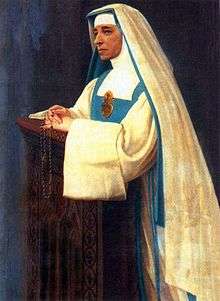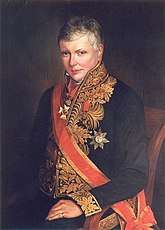Émilie d'Oultremont
Émilie d'Oultremont (11 October 1818 – 22 February 1878) – in religion Marie of Jesus – was a Belgian Roman Catholic widow and later professed religious who founded the Sisters of Mary Reparatrix.[1][2][3] She had four children and two of them, both daughters, joined her order and later predeceased her. She dedicated herself to the expansion of her order and sent religious to places such as England and India.[4][5]
Émilie d'Oultremont | |
|---|---|
 | |
| Religious | |
| Born | 11 October 1818 Wégimont, Belgium |
| Died | 22 February 1878 (aged 59) Florence, Kingdom of Italy |
| Venerated in | Roman Catholic Church |
| Beatified | 12 October 1997, Saint Peter's Square, Vatican City by John Paul II |
| Feast | 22 February |
| Attributes | Religious habit |
| Patronage | Sisters of Mary Reparatrix |
Pope John Paul II beatified her on 12 October 1997 in Saint Peter's Square.[6]
Life

Born to Émile d'Oultremont (21 July 1787 – 4 August 1851) and Marie-Charlotte de Lierneux de Presles (28 July 1785 – 14 September 1850) at the Wégimont Castle as a member of the House of d'Oultremont.[3] Her two brothers were Charles (1819-1874) and Théodore (1 May 1815-???). Her father served as the Belgian ambassador to the Vatican in Rome and she often accompanied him on his numerous visits across Europe.[6] In her childhood she came to learn about Ignatius of Loyola and came to foster a devotion to him and also fostered devotions to both the Eucharist and the Sacred Heart of Jesus Christ. In 1833 she went to live in Rome with her parents due to her father's diplomatic assignment and later moved there again from 1839 to 1846 (with her husband in tow this time) while going back to Belgium each summer.
After she turned eighteen her parents began to arrange a marriage for her despite her hesitation, though she later relented. On 19 October 1837 she married Victor van der Linden d’Hooghvorst (1813 – 10 August 1847); the couple had four children (two males and two females). Her husband died of malaria on 10 August 1847 leaving her a widow.[3][4] Her children were:
- Olympe (d. 14 December 1872)
- Marguerite (1814 – 23 January 1867)
- Adrien
- Edmond (1840 – 1890)
She sent her sons to school in France while she and her daughters went to live in Paris, though one of her aunts invited her to their castle at Bauffe before she left in 1854.[6] Her daughter Marguerite later died of tuberculosis in 1867 and Olympe followed on 14 December 1872.[4]
On 8 December 1854 (the date Pope Pius IX proclaimed the dogma of the Immaculate Conception) – while reflecting at a chapel in Bauffe – she described having experienced a vision of the Madonna. Feeling that she had been called to religious life she moved to Paris in 1854 and set up a small religious group in her home in 1855. In 1857 she established a convent at Strasbourg, and she later founded the Sisters of Mary Reparatrix on 1 May 1857; she made her vows on 2 May 1858.[3][6] Her two daughters joined that order while her two sons married. In 1859 she was asked to spread her order to India and so sent religious there in order to expand it.[5] She later sent religious to England in 1862 and Mauritius in 1866 amongst other places; she also oversaw the transfer of the motherhouse from Strasbourg to Rome.[5]
She died in 1878 in Florence while at her son Adrien's home. She has a shrine in the Santa Maria della Concezione dei Cappuccini in Rome.[5] She was buried at the church of Saint Bonaventure in Rome.
Beatification
The beatification process opened in several places in several independent processes. The informative process opened in Liège on 16 April 1913 and concluded in December 1918 after World War I, since the conflict posed a slight disruption to the cause. Another process – one of two supplementary processes – opened on 14 July 1928 in Rome and closed on 5 March 1930 while the second of these spanned from 25 March 1934 to 15 June 1935 also in Rome. Theologians also assumed charge of all of her spiritual writings and approved them on 22 July 1925, while issuing further approval on two more occasions on 26 March 1930 and 1 February 1939 after a greater evaluation of them. The formal introduction to the cause came on 2 July 1941 under Pope Pius XII and she was titled henceforth as a Servant of God. An apostolic process was opened in Rome on 20 March 1942 and closed on 15 July 1943, while another was held in Liège from 24 July 1942 until 8 October 1943. An apostolic rogatory process was opened in Toulouse on 18 June 1942 and closed on 14 April 1943 while a second one opened in Madrid on 5 July 1942 and closed on 25 February 1943. The Congregation of Rites validated all these previous processes on 8 March 1946 while an ante-preparatory congregation approved the cause's direction on 18 March 1952 as did a preparatory committee on 9 April 1957.
The Positio was submitted decades later in 1989 to the Congregation for the Causes of Saints while theologians approved the contents of the dossier on 25 May 1993; the C.C.S. did so as well on 16 November 1993. Pope John Paul II declared her to be Venerable on 23 December 1993 after he confirmed that she had lived a model life of heroic virtue.
The miracle required for beatification was investigated and then validated on 12 February 1994 which allowed for a medical board to approve it on 5 October 1995 and for theologians to do so as well on 19 January 1996, while the C.C.S. issued approval on 18 June 1996. John Paul II issued his final approval to this on 17 December 1996 and beatified the late religious on 12 October 1997.
References
- "Emilie's experience of God's Call". Our History. Sisters of Mary Reparatrix.
- Walsh, Michael (2015). Every Pilgrim's Guide to Rome. pp. 86–87. ISBN 1-84825-618-3.
- Gubin, Eliane (2006). Dictionnaire des femmes belges: XIXe et XXe siècles (in French). pp. 211–12. ISBN 2873864346.
- "Blessed Mary of Jesus". Santi e Beati. Retrieved 29 September 2016.
- "Blessed Émilie d'Oultremont d'Hoogvorst". Saints SQPN. 12 May 2016. Retrieved 29 September 2016.
- "Emilie – Who was this woman?". Our History. Sisters of Mary Reparatrix.